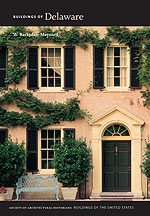
Here E. I. du Pont offered nondenominational general education to the children of factory workers. The institution followed an English reform movement that set up schools in industrial districts. His widowed daughter Victorine threw herself zealously into the enterprise, heading it for decades (1816–1861). A survey in 1826 by Jonas P. Fairlamb offers the earliest (though not very accurate) visual representation of the building, which had been built by local mason William Cleaden. Carpenter James Goodman reconstructed the roof and added a fanlit doorway (subsequently altered) and a “piazza” in 1845. Nineteenth-century drawings thought to be by Alfred Victor du Pont show the Ionic capitals employed here, which may have been recycled from some earlier du Pont mansion. In later years, the building served as the Hagley Yard office of the DuPont Company (1902–1921), after which it was a private home until 1974. A restoration five years later reapplied stucco to the walls and returned the interior to its schoolhouse days, based on an old sketch by Sophie du Pont.

